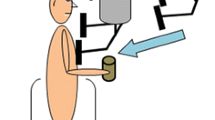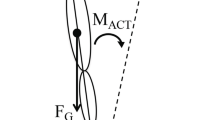Abstract
Coupling stability during cyclic arm movements in the horizontal (transverse) plane is lower in ISO- than in ANTI-directional coupling. We proposed that such impairment arises from the interference exerted in ISO by the anticipatory postural adjustments (APAs) linked to the primary movements. To evaluate if a link between coupling stability and postural adjustments also exist for arm movements with different postural requirements, we focused on arm(s) flexion–extension in the parasagittal plane and started by analysing the APAs distribution in arm, trunk and leg muscles. Fast flexion and extension of the right arm elicited APAs in the left anterior and posterior deltoid that replicated the excitation–inhibition of the homologous prime movers; this pattern would favour ISO and contrast ANTI-coupled movements. Instead, in the left latissimus dorsi, APAs were opposite to the voluntary actions in the right latissimus dorsi, thus favouring ANTI coupling. Symmetrical APAs were also elicited in right and left erector spinae (rES, lES) and asymmetrical APAs in Ischiocruralis (rIC, lIC), while an antero-posterior force (Fy) and a moment about the vertical axis (Tz) were discharged to the ground. When fast discrete movements were ISO-coupled, APAs were symmetrical in trunk (rES, lES) and leg (rIC, lIC) muscles and a large Fy but no Tz was generated. In ANTI coupling, APAs in rES and lES remained symmetrical, whereas they became antisymmetrical in rIC and lIC. A large Tz and a small Fy were recorded. In conclusion, during parasagittal movements, APAs in are elicited in both ISO and ANTI coupling, at variance with horizontal movements where they are only present in ISO. This would suggest that the difference in coupling stability between the two modes is smaller (or even reversed) in parasagittal with respect to horizontal arm movements.




Similar content being viewed by others
Notes
Basic mechanics indicate that two reactions are generated at the shoulder: (1) a reaction torque (T R ) around the inter-shoulder axis in response to the prime movers action; and (2) a backward constraint force (F C ) in response to the forward acceleration of the arm centre of mass. T R will produce a forward displacement of the CoP while F C is discharged at the CoP as Fy plus (1) a torque about the mediolateral axis, opposite to T R (lever arm, the shoulder height), and (2) a torque Tz (lever arm, distance from shoulder to body vertical axis).
References
Aruin AS, Latash ML (1995) Directional specificity of postural muscles in feed-forward postural reactions during fast voluntary arm movements. Exp Brain Res 103:323–332
Baldissera F, Esposti R (2005) Postural constraints to coupling of ipsilateral hand-foot movements. NeuroReport 16:1615–1619
Baldissera F, Hultborn H, Illert M (1981) Integration in spinal neuronal systems. In: Brookhart JM, Mountcastle VB, Brooks VB, Geiger SR (eds) Handbook of physiology, section I, the nervous system, vol 2., Motor ControlAmerican Physiological Society, Bethesda, pp 509–595
Baldissera F, Cavallari P, Civaschi P (1982) Preferential coupling between voluntary movements of ipsilateral limbs. Neurosci Lett 34:95–100
Baldissera F, Borroni P, Cavallari P (2000) Neural compensation for mechanical differences between hand and foot during coupled oscillations of the two segments. Exp Brain Res 133:165–177
Baldissera F, Borroni P, Cavallari P, Cerri G (2002) Excitability changes in human corticospinal projections to forearm muscles during voluntary movement of ipsilateral foot. J Physiol 539:903–911
Baldissera F, Rota V, Esposti R (2008a) Anticipatory postural adjustments in arm muscles associated with movements of the contralateral limb and their possible role in interlimb coordination. Exp Brain Res 185:63–74
Baldissera F, Rota V, Esposti R (2008b) Postural adjustments in arm and leg muscles associated with isodirectional and antidirectional coupling of upper limb movements in the horizontal plane. Exp Brain Res 190:289–305
Belen’kii VE, Gurfinkel’ VS, Pal’tsev EI (1967) Control elements of voluntary movements. Biofizika 12:135–141
Bleuse S, Cassim F, Blatt JL, Defebvre L, Derambure P, Guieu JD (2005) Vertical torque allows recording of anticipatory postural adjustments associated with slow, arm-raising movements. Clin Biomech (Bristol, Avon) 20:693–699
Borroni P, Cerri G, Baldissera F (2004) Excitability changes in resting forearm muscles during voluntary foot movements depend on hand position: a neural substrate for hand-foot isodirectional coupling. Brain Res 1022:117–125
Bouisset S, Do MC (2008) Posture, dynamic stability, and voluntary movement. Neurophysiol Clin 38:345–362
Bouisset S, Zattara M (1987) Biomechanical study of the programming of anticipatory postural adjustments associated with voluntary movement. J Biomech 20:735–742
Carson RG, Goodman D, Kelso JA, Elliott D (1995) Phase transitions and critical fluctuations in rhythmic coordination of ipsilateral hand and foot. J Mot Behav 27:211–224
Cerri G, Borroni P, Baldissera F (2003) Cyclic H-reflex modulation in resting forearm related to contractions of foot movers, not to foot movement. J Neurophysiol 90:81–88
Cordo PJ, Nashner LM (1982) Properties of postural adjustments associated with rapid arm movements. J Neurophysiol 47:287–302
Crone C, Hultborn H, Jespersen B, Nielsen J (1987) Reciprocal Ia inhibition between ankle flexors and extensors in man. J Physiol 389:163–185
Esposti R, Esposito F, Ce E, Baldissera F (2010) Difference in the metabolic cost of postural actions during iso- and antidirectional coupled oscillations of the upper limbs in the horizontal plane. Eur J Appl Physiol 108:93–104
Friedli WG, Hallett M, Simon SR (1984) Postural adjustments associated with rapid voluntary arm movements 1. Electromyographic data. J Neurol Neurosurg Psychiatry 47:611–622
Geertsen SS, Stecina K, Meehan CF, Nielsen JB, Hultborn H (2011) Reciprocal Ia inhibition contributes to motoneuronal hyperpolarisation during the inactive phase of locomotion and scratching in the cat. J Physiol 589:119–134
Hodges P, Cresswell A, Thorstensson A (1999) Preparatory trunk motion accompanies rapid upper limb movement. Exp Brain Res 124:69–79
Hodges PW, Cresswell AG, Daggfeldt K, Thorstensson A (2000) Three dimensional preparatory trunk motion precedes asymmetrical upper limb movement. Gait Posture 11:92–101
Jeka JJ, Kelso JA (1995) Manipulating symmetry in the coordination dynamics of human movement. J Exp Psychol Hum Percept Perform 21:360–374
Kasai T, Komiyama T (1988) The timing and the amount of agonist facilitation and antagonist inhibition of varying ankle dorsiflexion force in man. Brain Res 447:389–392
Kelso JA, Jeka JJ (1992) Symmetry breaking dynamics of human multilimb coordination. J Exp Psychol Hum Percept Perform 18:645–668
Lee LJ, Coppieters MW, Hodges PW (2009) Anticipatory postural adjustments to arm movement reveal complex control of paraspinal muscles in the thorax. J Electromyogr Kinesiol 19:46–54
Marsden CD, Merton PA, Morton HB (1981) Human postural responses. Brain 104:513–534
Massion J (1992) Movement, posture and equilibrium: interaction and coordination. Prog Neurobiol 38:35–56
Petersen N, Morita H, Nielsen J (1999) Modulation of reciprocal inhibition between ankle extensors and flexors during walking in man. J Physiol 520:605–619
Pyndt HS, Laursen M, Nielsen JB (2003) Changes in reciprocal inhibition across the ankle joint with changes in external load and pedaling rate during bicycling. J Neurophysiol 90:3168–3177
Schepens B, Drew T (2004) Independent and convergent signals from the pontomedullary reticular formation contribute to the control of posture and movement during reaching in the cat. J Neurophysiol 92(4):2217–2238
Schepens B, Drew T (2006) Descending signals from the pontomedullary reticular formation are bilateral, asymmetric, and gated during reaching movements in the cat. J Neurophysiol 96(5):2229–2252
Schepens B, Stapley P, Drew T (2008) Neurons in the pontomedullary reticular formation signal posture and movement both as an integrated behavior and independently. J Neurophysiol 100(4):2235–2253
Serrien DJ, Swinnen SP (1998) Load compensation during homologous and non-homologous coordination. Exp Brain Res 121:223–229
Shiratori T, Aruin AS (2004) Anticipatory postural adjustments associated with rotational perturbations while standing on fixed and free-rotating supports. Clin Neurophysiol 115:797–806
Swinnen SP (2002) Intermanual coordination: from behavioural principles to neural-network interactions. Nat Rev Neurosci 3:348–359
Tanaka R (1974) Reciprocal Ia inhibition during voluntary movements in man. Exp Brain Res 21:529–540
Teyssèdre C, Lino F, Zattara M, Bouisset S (2000) Anticipatory EMG patterns associated with preferred and non-preferred arm pointing movements. Exp Brain Res 134:435–440
Tomita H, Fukaya Y, Honma S, Ueda T, Yamamoto Y, Shionoya K (2010) Anticipatory postural muscle activity associated with bilateral arm flexion while standing in individuals with spastic diplegic cerebral palsy: a pilot study. Neurosci Lett 479:166–170
Yiou E (2005) Performance and postural interactions during synchronous pointing and leg flexion. Med Sci Sports Exerc 37:91–99
Yiou E, Do MC (2011) Effects of medio-lateral postural perturbation induced by voluntary arm raising on the biomechanical organization of rapid step initiation. Mot Control 15:507–524
Yiou E, Schneider C (2007) Coordination of pointing and stepping: do postural phenomena result from the juxtaposition of the dynamics of each task? Neurosci Lett 425:63–68
Zattara M, Bouisset S (1988) Posturo-kinetic organisation during the early phase of voluntary upper limb movement. 1 normal subjects. J Neurol Neurosurg Psychiatry 51:956–965
Acknowledgments
This study was supported by a PUR grant from the Università degli Studi di Milano.
Author information
Authors and Affiliations
Corresponding author
Rights and permissions
About this article
Cite this article
Esposti, R., Baldissera, F.G. The role of anticipatory postural adjustments (APAs) in interlimb coordination of coupled arm movements in the parasagittal plane: I. APAs associated with fast discrete flexion and extension movements of one arm or of both arms ISO- and ANTI-directionally coupled. Exp Brain Res 228, 527–539 (2013). https://doi.org/10.1007/s00221-013-3584-3
Received:
Accepted:
Published:
Issue Date:
DOI: https://doi.org/10.1007/s00221-013-3584-3




